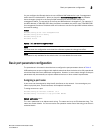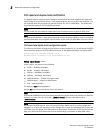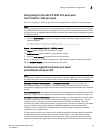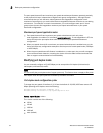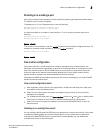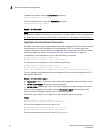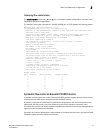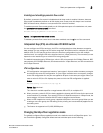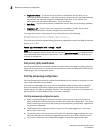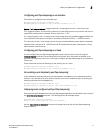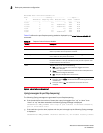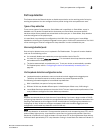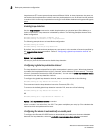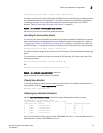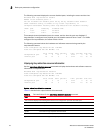
Brocade ICX 6650 Administration Guide 39
53-1002600-01
Basic port parameter configuration
2
Enabling and disabling symmetric flow control
By default, symmetric flow control is disabled and tail drop mode is enabled. However, because
flow control is enabled by default on all full-duplex ports, these ports will always honor received
802.3x Pause frames, whether or not symmetric flow control is enabled.
To enable symmetric flow control globally on all full-duplex data ports of a standalone unit, enter
the symmetric-flow-control enable command.
Brocade(config)# symmetric-flow-control enable
Syntax: [no] symmetric-flow-control enable
To disable symmetric flow control once it has been enabled, use the no form of the command.
Interpacket Gap (IPG) on a Brocade ICX 6650
switch
You can configure an IPG for each port. An IPG is a configurable time delay between successive
data packets. You can configure an IPG with a range from 48-120 bit times in multiples of 8, with a
default of 96. The IPG may be set from either the interface configuration level or the multiple
interface level. You configure IPG at the interface level on 1 Gbps ports only. The command you use
depends on the interface type on which IPG is being configured.
The default interpacket gap is 96 bits-time, which is 9.6 microseconds for 10 Mbps Ethernet, 960
nanoseconds for 100 Mbps Ethernet, 96 nanoseconds for 1 Gbps Ethernet, and 9.6 nanoseconds
for 10 Gbps Ethernet.
IPG configuration notes
• IPG configuration commands are based on "port regions". All ports within the same port region
should have the same IPG configuration. If a port region contains two or more ports, changes
to the IPG configuration for one port are applied to all ports in the same port region. When you
enter a value for IPG, the CLI displays the ports to which the IPG configuration is applied.
Example
Brocade(config-if-e10000-1/2/1)# ipg 48
Syntax: ipg <decimal>
The <decimal> variable specifies a range between 48 to 120, in multiples of 8.
• When you enter a value for IPG, the device applies the closest valid IPG value for the port mode
to the interface. For example, if you specify 120 for a 1 Gbps Ethernet port in 1 Gbps mode, the
device assigns 112 as the closest valid IPG value to program into hardware.
• When an IPG is applied to a trunk group, it applies to all ports in the trunk group. When you are
creating a new trunk group, the IPG setting on the primary port is automatically applied to the
secondary ports.
• This feature is supported on 10/100/1000M ports.
Changing the Gbps fiber negotiation mode
The globally configured Gbps negotiation mode is the default mode for all Gbps fiber ports. You
can override the globally configured default and set individual ports to the following:



